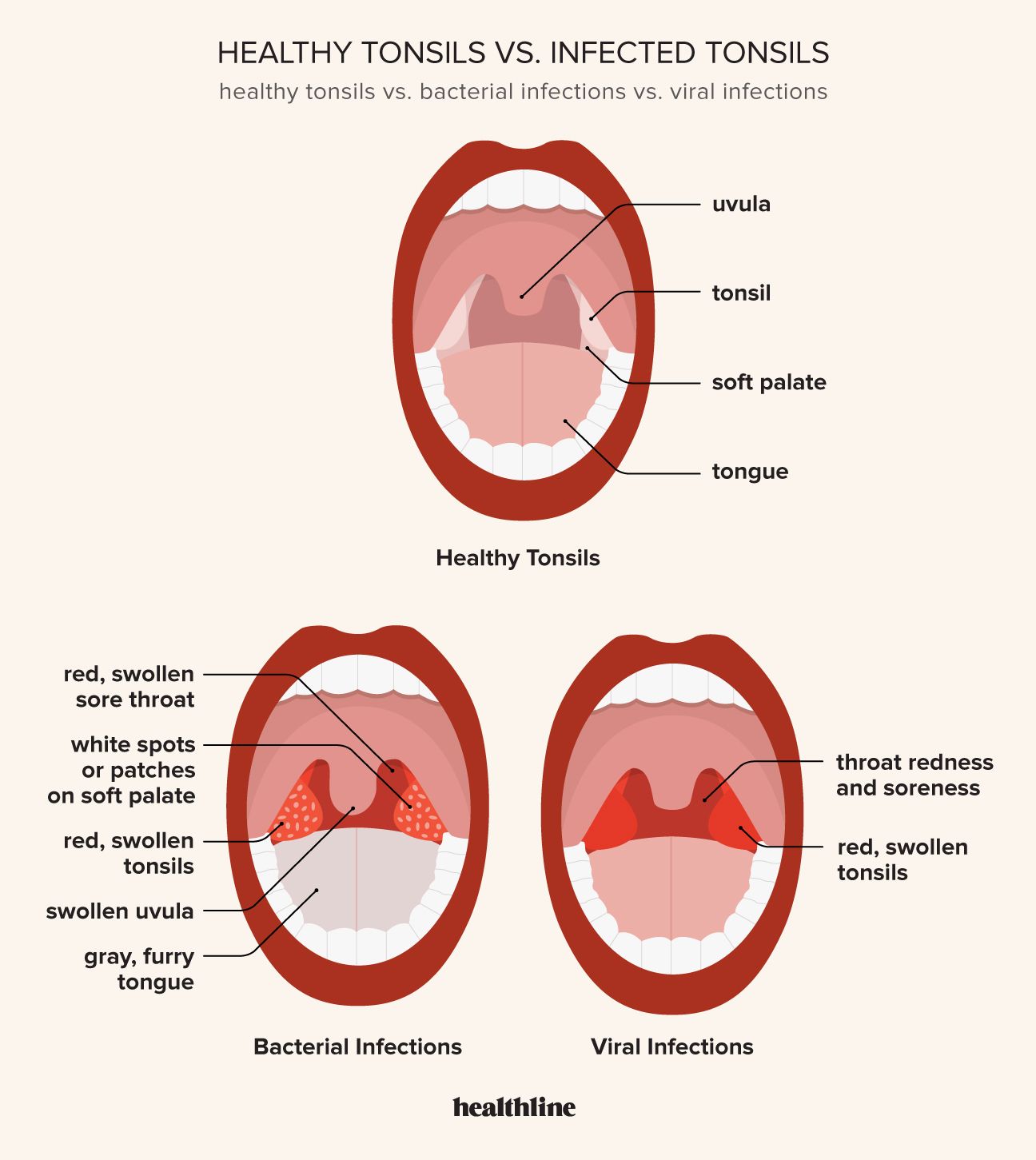You can examine tonsils yourself to check for an infection. Healthy tonsils are pink and don’t stick out far from the sides of your throat. Infected tonsils are typically red and swollen.
Tonsils are oval-shaped nodes on both sides of the back of the throat. They can help the immune system clear out viruses and bacteria that enter through the mouth and nose.
When they’re healthy, lymph nodes are pinkish and don’t take up too much space in the throat. But they can swell and turn red if they become infected or inflamed. It’s worth noting that some people have naturally large (or hypertrophic) tonsils. This doesn’t mean they’re sick.
Infected or swollen lymph nodes can be a symptom of several conditions or illnesses. If you’re not feeling well, have a sore throat, or suspect your tonsils may be infected, you can look at them yourself to check for an infection.

Inflamed tonsils are red and swollen. They usually cause a sore throat. They may also cause a fever and difficulty swallowing, among other symptoms.
You can check for swollen tonsils yourself. Here’s how:
- Step 1: Drink water or rinse your throat to remove any food particles in your throat.
- Step 2: Stand in front of a mirror. If the room is dark, it may help to have a flashlight. A phone’s light can work, too.
- Step 3: Open your mouth as wide as possible. Push your tongue into the bottom of your mouth or stick it out straight. You need a clear view of your throat. Tip: Saying “aaaahh” can help you get a better view of your throat when sticking out your tongue.
- Step 4: Look back into your throat. The tonsils sit about midway in your throat, on either side.
If they’re healthy, tonsils are pinkish, and they may not stick out far from the sides of your throat.
If they’re infected, however, they’re likely red and swollen. You may also notice a yellow or white coating on the tonsils. White spots on them are possible, too.
When to get medical help
If you see inflamed tonsils, you may need to contact a doctor. While some infections can clear on their own, some need medical attention. In addition to inflamed tonsils, consider contacting a doctor if you have these symptoms:
- fever
- neck pain
- skin rash
- headache
- earache
- difficulty swallowing or breathing
An infection in the tonsils is called tonsillitis. It usually occurs from a virus or bacteria. Many doctors will do additional tests to understand the cause of your tonsillitis so they can properly treat you.
Potential health concerns associated with tonsillitis include:
- Viruses: Common viruses like rhinovirus, adenovirus, and coronavirus can cause the common cold or cold-like illnesses. In addition to symptoms like runny nose and sneezing, people with swollen tonsils from a viral infection may experience a sore throat.
- Flu: The flu virus can cause swollen tonsils. Symptoms of the flu include fever, body aches, and sore throat.
- Mono: Mononucleosis is a disease spread by a virus. It usually occurs from the Epstein-Barr virus. In addition to a sore throat, it can cause a rash, headache, and fatigue.
- Bacteria: Most commonly, the bacterium for strep throat (group A Streptococcus) can cause tonsil irritation and inflammation. Other symptoms include neck pain, fever, and sore throat.
- Abscess: A pocket of infection can develop near or in the tonsils. This is called a peritonsillar abscess. Other symptoms include fever, headache, and earache.
- Tonsil stones: Small white or yellow lumps can develop in the tonsils. They can cause tonsil pain, bad taste, and bad breath.
- Enlarged tonsils: Swollen tonsils can block the airway and make breathing and swallowing difficult. They may also cause health concerns like sleep apnea and snoring.
If you think you may have swollen tonsils, your doctor may do a thorough exam to identify potential causes and treatments. That process begins with asking about symptoms and getting a full history of what you’ve been experiencing.
From there, the doctor may do an exam. This includes looking at the throat and possibly your nose and ears. They can look specifically at the back of the throat and inside of the mouth.
If they suspect a viral or bacterial infection, the doctor can order a few tests that can help clarify a potential cause. They can use a long, soft cotton swab to collect a sample of the saliva at the back of the throat. Healthcare professionals can quickly test this in the office for some illnesses, like the flu and strep throat.
A doctor may also test for SARS-CoV-2 (the virus that causes COVID-19), as well as do a full viral panel or a gonorrhea/Chlamydia swab if symptoms or risk factors are present.
If those come back negative, healthcare professionals may send the samples to a lab for further testing. This testing process will look at other potential causes.
Once the healthcare professionals find the cause, the doctor may prescribe a treatment, such as antibiotics.
The tonsils are an important part of the body’s immune system. They protect against viruses and bacteria that enter the nose and throat. Sometimes, however, the tonsils can become infected or inflamed. A sore throat is common if this happens.
You can see whether you have red or swollen tonsils by looking at them in a mirror. To do this, open your mouth, stick out your tongue, and look at the middle part of the throat. Inflamed tonsils are often red and enlarged.
Sometimes, inflamed tonsils and whatever causes them will pass quickly. But other times, you may need treatment. Contact a doctor for a diagnosis if you develop health concerns like a fever, neck pain, rash, and difficulty breathing.
